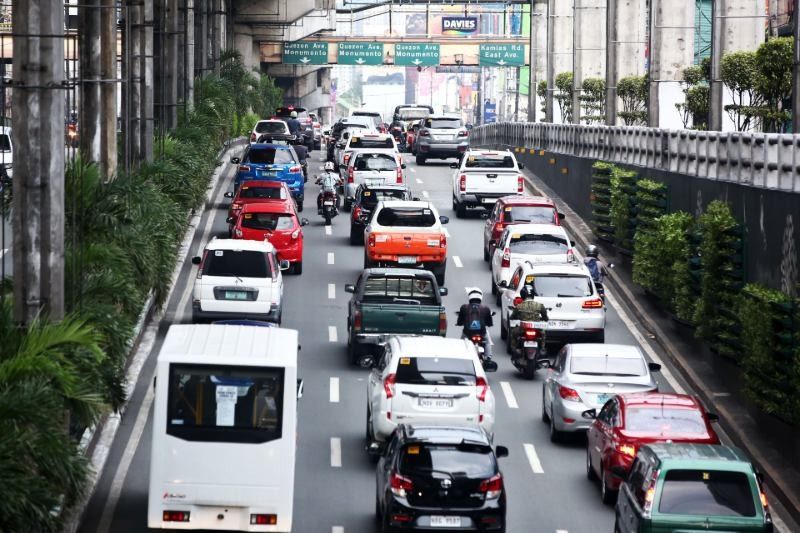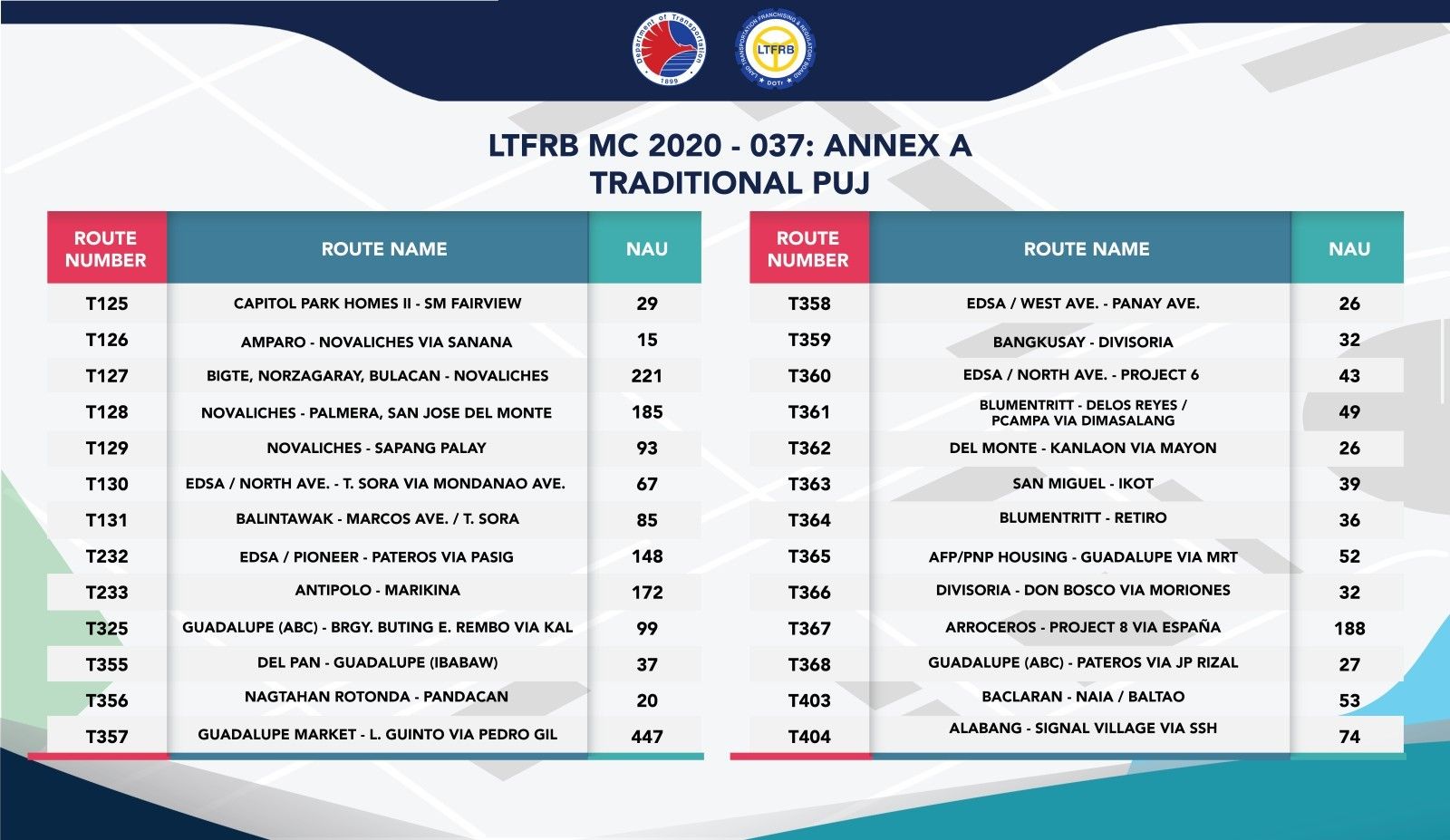Transpo officials hopeful that earlier GCQ mistakes have been addressed

MANILA, Philippines — Transportation authorities are hopeful that the plethora of added routes and units will be enough to service the demand for public transportation as Metro Manila shifts to general community quarantine anew.
Preparations for traditional public utility jeepneys now include a total of 12,443 in 126 routes, the Land Transportation Franchising and Regulatory Board disclosed in a statement sent to reporters, a number that is still but a fraction of the 74,000 public utility jeepneys idled following the suspension of mass transportation at the onset of the enhanced community quarantine.
“This is very small compared to the actual number of jeepneys in Metro Manila. Many drivers and operators remain hungry," transport group Piston said in July when the department only allowed some 6,000 jeepneys to ply their routes once more.
RELATED: Most drivers jobless amid partial resumption of jeepney operations — Piston
At the time, the group pointed out that there are 579 routes through which approximately 74,000 jeepneys operate in NCR alone, totaling about 150,000 drivers and 50,000 operators. As a result, when general community quarantine was implemented, public transportation was caught largely flat-footed leaving countless commuters to fend for themselves.
Speaking to reporters in an online press conference Tuesday afternoon, though, LTFRB chair Martin Delgra said that the department was more ready for a public transport reopening than it was in June, when the first GCQ was implemented and when public transport was caught severely lacking, leaving many commuters on their own.
"I would like to think that this time we are better equipped to address that. I would like to think that what will happen tomorrow will be quite an improvement from when we opened up public transport on June 1," Delgra said.
"Unlike before when we were looking at routes, more importantly at this point in time, we need to manage people. And that is not just moving people but also coordinating with other stakeholders in managing people. So we continue to coordinate with local governments, especially for provincial bus routes that enter Metro Manila," he added.
READ: Lack of PUVs in Metro Manila alarms House panel

In a manifesto calling for the re-imposition of ECQ to give healthcare workers a "time-out," the Philippine College of Physicians also called for reforms in public transportation, saying: "This problem cannot be addressed by long-term infrastructure."
"We need prompt and rapid solutions with long-term impact such as the immediate implementation of service contracting, pop-up bicycle lanes, and pedestrian lanes. Workers need more transportation options to prevent congestion in public streets. We need these now, not next year, because people need to get to work but have no safe transport options," it also said.
'Still far from sufficient'
In a text message, transport economist and advocate Robert Siy told Philstar.com: “Every bit helps, but the numbers are still far from sufficient."
"With the return to GCQ, more people will need public transport; if supply is inadequate, there will be pressure to crowd inside vehicles and at stops and terminals. The numbers announced by LTFRB are the vehicles authorized to operate, but the figures do not reflect the services that are available; the reality is that many transport operators decide not to operate, even after being authorized, because they are not able to earn enough due to the physical distancing and reduced capacity inside vehicles," Siy said.
"This is the basic reason why service contracting is essential—it will ensure that operators deliver needed services while remaining financially viable. More public transport capacity will help to reduce the risk of virus transmission when people move around our cities," he added.
RELATED: Transport coalition hits slashed public transport budget under Bayanihan 2
The Move as One transport coalition, of which Siy is a member, has long been calling for the national government to "rescue and reform the public transport industry" with a proposed P110-billion stimulus fund, which includes a service contracting scheme for public utility vehicles and their operators, where operators are paid to ply their routes and service commuters regardless of how many passengers get on.
Among the coalition's principal calls are the construction of active transport infrastructure, as commuters continue to shift to cycling.
"At the same time, walking and cycling need to be safe travel options for those unable to access public transport. Protected bike lanes should be a top priority of MMDA and LGUs. If more people shift to cycling, we reduce the potential for crowding on severely limited public transport services,” Siy also said.
Asked about the possibility of deploying more units, LTFRB Board Member Ronaldo Corpus said: "We follow the hierarchy in issuing units [depending on] how much passengers can ride...we also have a policy against 25% overlaps in routes to prevent competition. We'll have problems if this happens. Another policy is we respect whoever travels on a route the longest [and] we call it the prior operator rule."
Aid for idled drivers
Asked for numbers on the social amelioration distribution for drivers and operators, though, the board deferred to the Department of Social Welfare and Development, which handles the long-delayed program.
LTFRB Information Systems Management head Nida Quibic disclosed that some P88,054 from regional offices is scheduled for payout by the DSWD.
"We commiserate with our stakeholders, especially our drivers and operators, they have been hit hard by this pandemic," Delgra said.
READ: Jeepney drivers have not received aid months into quarantine — Piston
"That's on one side, but on the other side, we need to bring the economy back on its feet, and that includes public transport. The plan really is that the aid being given to them continues...but we need them also to address the public transport need," he added.
Earlier on Tuesday, August 11, though, Piston said that many of its drivers still have not received any aid from the government after the DSWD asked the group to submit another master list for drivers and operators in need of assistance after they had already submitted one to the LTFRB previously.
Philstar.com has also reached out to Floranda for comment, though he has not responded as of this publishing.
'Railways, PUVs ready for commuters come GCQ'
According to the DOTr, the rail sector is also ready to ferry passengers:
- The MRT-3 line is ready to dispatch 16 CKD train sets and 2 Dalian train sets on a daily basis
- The LRT-1 line is prepared to dispatch on weekdays 24 train sets for the morning peak hours, 18 train sets for the off-peak hours, and 24 train sets during the afternoon peak hours.
- The LRT Line 2 will be deploying 5 trains sets daily.
- The Philippine National Railways (PNR) is ready to deploy 10 train sets on a daily basis.
The department also highlighted that a “No face mask and no face shield, no ride” policy will be strictly enforced in all sectors of public transportation.
"This is not part of public transport, but since we're addressing a public health emergency, we really do need these restrictions. Other agencies are also mandating the use of face shields, so when it comes to public transport, there are corresponding penalties that will be enforced. We appeal with drivers, operators, and especially commuters to comply with this," Delgra said.
"We're back to GCQ and therefore public transport is allowed. So this is a reminder to operators to prepare their vehicles to be roadworthy and compliant with public health protocols. Obviously the challenge is still there, and there is need for public transport. We hope we will be able to address this."
LTFRB presents its PUV routes under GCQ, all of which will be opened simultaneously starting tomorrow. LTFRB chair Martin Delgra says, "Hopefully this will avoid and avert problems in lacking public transport." @PhilstarNews pic.twitter.com/4qnS0oQbnu
— Franco Luna (@francoIuna) August 18, 2020
- Latest
- Trending




























